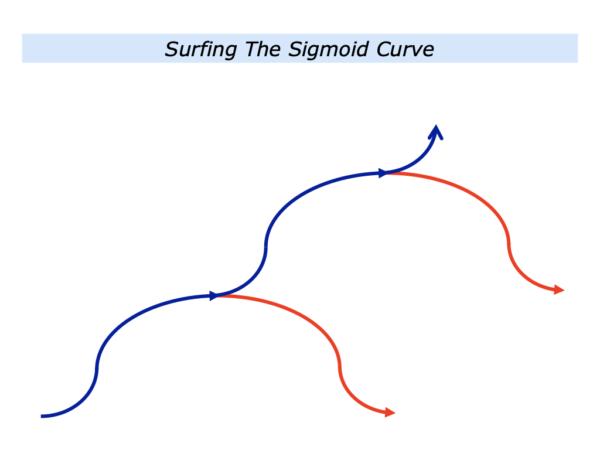
There are many ways to do fine work. One approach is followed by many pacesetters. It is to keep developing and surfing the sigmoid curve. Let’s explore this approach.
Charles Handy popularised the sigmoid curve approach his book The Age of Paradox. Originally a mathematical term, it can also be used to track the development of a product, an organisation or even a civilisation.
People can also apply this approach to their careers. As one curve reaches its peak, they can aim to create and surf onto the next sigmoid curve. They can then keep doing stimulating work and developing rather than lapse into what they see as decline.
Different people will be at different stages of the curve at different stages of their careers. Sometimes they get the right balance between stability and doing stimulating work that helps them to develop. Sometimes they stay too long at a certain stage. One person expressed this in the following way.
“My greatest challenge has been deciding how long to stay in a particular role. Looking back at the jobs I have had, sometimes I kept growing and did fine work.
“At other times, however, I have stayed too long. Sometimes I lapsed into cruise control, when really I should have developed my successor and moved on.”
You will make your own decisions regarding how you can continue developing in your own way. If you wish, however, it can sometimes be useful to explore the following themes.
You Can Clarify Where You
Are On The Sigmoid Curve
Imagine you are climbing the curve in a specific aspect of your professional life. Where are you now?
Perhaps you are halfway up the curve. Feeling hungry, you may believe there is lots of scope for development. On the other hand, you may have hit a ceiling or believe that your own growth – or the product or service you offer – is deteriorating.
Looking at the wider picture, the sigmoid curve approach also has implications for businesses. Many companies invest heavily in research and aiming to climb or create a new curve.
The reality is that they may money, however, from the products that have already reached their peak or are in decline. It is therefore important to maintain high standards when delivering the older services and products.
This approach may also call for employing different kinds of people in different parts of the business. Such an approach means that it is possible:
To continue developing new products … To continue capitalising on the older products that are providing the money for the new developments.
Many people are attracted to creating the new products but the research and development stages seldom brings early returns. It is therefore important to provide encouragement for those who are making money from the older products.
Let’s return to your present work. Imagine you are still climbing the curve. How can you keep developing? How can you keep building on your strengths? How can you stay close to your customers and help them succeed?
If you wish, try tackling the exercise on this theme. Describe a specific aspect of your professional life that you want to focus on. Describe where you are on the sigmoid curve in this aspect of your professional life.
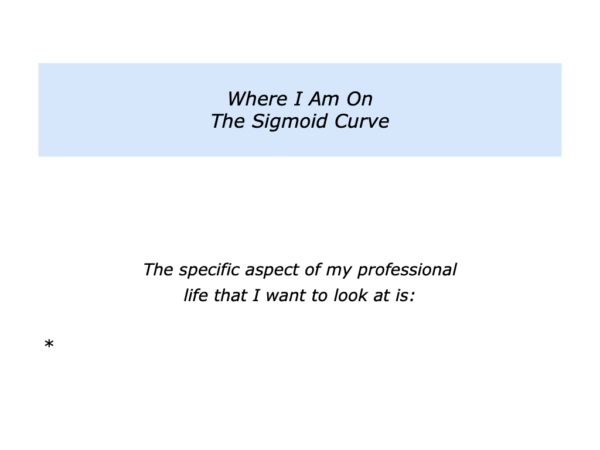
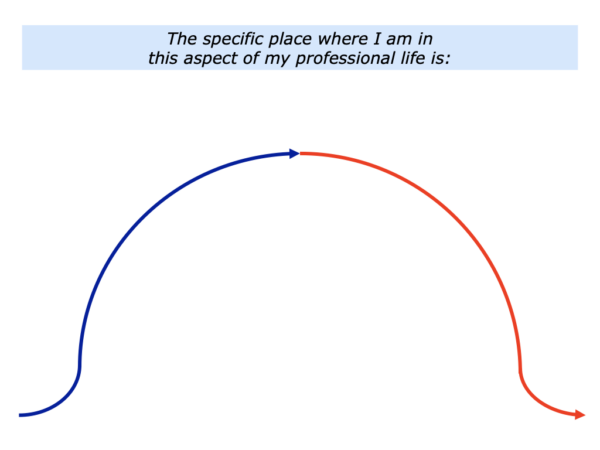
You Can Surf Onto
The Next Sigmoid Curve
Imagine that you want to surf onto the next curve. Bearing in mind your strengths, it can be useful to explore the following themes.
How can I stay ahead of the game? Looking at my professional life, what will be happening in my field in the next three years? What may be the innovations and challenges that people face? How can I spend time with pacesetting customers who will be focusing on these issues?
How can I build on my strengths to create services or products that will tackle these issues? How can I help these pacesetting customers to succeed? How can I build successful prototypes? How can I do these things and create or surf onto the next sigmoid curve?
If you wish, try tackling the exercise on this theme. Describe the specific things you can do to find or create the next sigmoid curve.
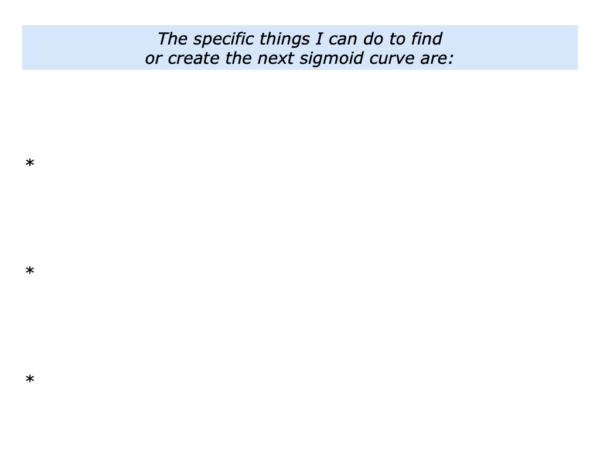
You Can Climb The Sigmoid Curve
But Also Be Aware Of Warning Signs
Pioneering workers often enjoy building new things. When appropriate, they may therefore hand over the new service or product to other people who can maximise its value for the company.
Let’s return to your own work. Imagine that you are enjoying climbing a new sigmoid curve. It may be important to be positively engaged but also recognise any warning signs that mean you lose concentration. Bearing this in mind, it can be useful to explore the following themes.
How can I continue to do stimulating work? How can I do this in a way that works for my customers? How can I deliver a superb service or product? When appropriate, how can I hand over this knowledge to other people so they can apply it in the company?
How can I stay fully focused and do superb work on this sigmoid curve? How can I be aware of any potential warning signs – such as losing interest? How can I make sure I deliver the goods properly before focusing on the next sigmoid curve?
Let’s assume that you are doing superb work on producing a new service or product. As mentioned, it can be important to deliver the goods properly before moving on to surfing the next sigmoid curve. How can you do this in your own way?
If you wish, try tackling the final exercise on this theme. This invites you to complete the following sentences.
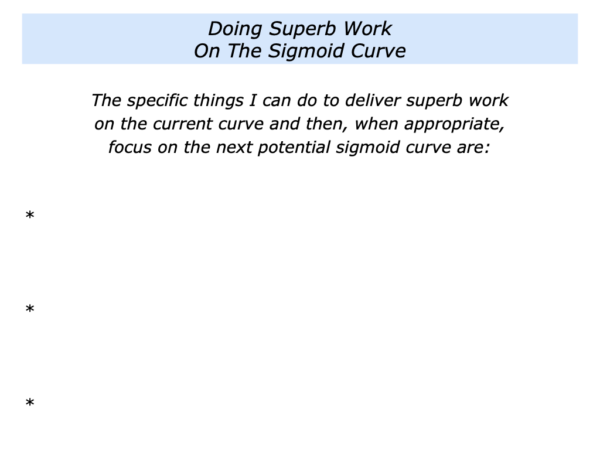






Leave a Reply